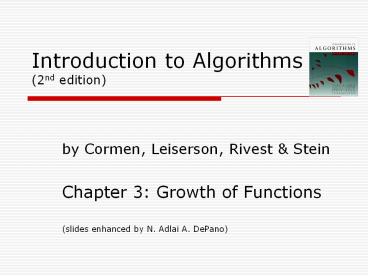Introduction%20to%20Algorithms%20(2nd%20edition) PowerPoint PPT Presentation
Title: Introduction%20to%20Algorithms%20(2nd%20edition)
1
Introduction to Algorithms(2nd edition)
- by Cormen, Leiserson, Rivest Stein
- Chapter 3 Growth of Functions
- (slides enhanced by N. Adlai A. DePano)
2
Overview
- Order of growth of functions provides a simple
characterization of efficiency - Allows for comparison of relative performance
between alternative algorithms - Concerned with asymptotic efficiency of
algorithms - Best asymptotic efficiency usually is best choice
except for smaller inputs - Several standard methods to simplify asymptotic
analysis of algorithms
3
Asymptotic Notation
- Applies to functions whose domains are the set of
natural numbersN 0,1,2, - If time resource T(n) is being analyzed, the
functions range is usually the set of
non-negative real numbers T(n) ? R - If space resource S(n) is being analyzed, the
functions range is usually also the set of
natural numbers S(n) ? N
4
Asymptotic Notation
- Depending on the textbook, asymptotic categories
may be expressed in terms of -- - set membership (our textbook) functions belong
to a family of functions that exhibit some
property or - function property (other textbooks) functions
exhibit the property - Caveat we will formally use (a) and informally
use (b)
5
The T-Notation
T(g(n)) f(n) ?c1, c2 gt 0, n0 gt 0 s.t. ?n
n0 c1 g(n) f(n)
c2 g(n)
6
The O-Notation
O(g(n)) f(n) ?c gt 0, n0 gt 0 s.t. ?n n0
f(n) c g(n)
7
The O-Notation
O(g(n)) f(n) ?c gt 0, n0 gt 0 s.t. ?n n0
f(n) c g(n)
8
The o-Notation
o(g(n)) f(n) ?c gt 0 ?n0 gt 0 s.t. ?n n0
f(n) c g(n)
9
The ?-Notation
?(g(n)) f(n) ?c gt 0 ?n0 gt 0 s.t. ?n n0
f(n) c g(n)
10
Comparison of Functions
Transitivity
- f(n) O(g(n)) and g(n) O(h(n)) ? f(n)
O(h(n)) - f(n) O(g(n)) and g(n) O(h(n)) ? f(n)
O(h(n)) - f(n) T(g(n)) and g(n) T(h(n)) ? f(n)
T(h(n)) - f(n) O(f(n)) f(n) O(f(n)) f(n) T(f(n))
Reflexivity
11
Comparison of Functions
- f(n) T(g(n)) ?? g(n) T(f(n))
- f(n) O(g(n)) ?? g(n) O(f(n))
- f(n) o(g(n)) ?? g(n) ?(f(n))
- f(n) O(g(n)) and f(n) O(g(n)) ? f(n)
T(g(n))
Symmetry
Transpose Symmetry
Theorem 3.1
12
Asymptotic Analysis and Limits
13
Comparison of Functions
- f1(n) O(g1(n)) and f2(n) O(g2(n)) ?
f1(n) f2(n) O(g1(n) g2(n)) - f(n) O(g(n)) ? f(n) g(n) O(g(n))
14
Standard Notation and Common Functions
- Monotonicity
- A function f(n) is monotonically increasing if m
? n implies f(m) ? f(n) . - A function f(n) is monotonically decreasing if m
? n implies f(m) ? f(n) . - A function f(n) is strictly increasing if m lt n
implies f(m) lt f(n) . - A function f(n) is strictly decreasing if m lt n
implies f(m) gt f(n) .
15
Standard Notation and Common Functions
- Floors and ceilings
- For any real number x, the greatest integer less
than or equal to x is denoted by ?x?. - For any real number x, the least integer greater
than or equal to x is denoted by ?x?. - For all real numbers x, x?1 lt ?x? ? x ? ?x? lt
x1. - Both functions are monotonically increasing.
16
Standard Notation and Common Functions
- Exponentials
- For all n and a?1, the function an is the
exponential function with base a and is
monotonically increasing. - Logarithms
- Textbook adopts the following convention lg n
log2n (binary logarithm), ln n logen
(natural logarithm), lgk n (lg n)k
(exponentiation), lg lg n lg(lg n)
(composition), lg n k (lg n)k (precedence
of lg).
ai
17
Standard Notation and Common Functions
- Important relationships
- For all real constants a and b such that agt1,
nb o(an) that is, any exponential function
with a base strictly greater than unity grows
faster than any polynomial function. - For all real constants a and b such that agt0,
lgbn o(na) that is, any positive polynomial
function grows faster than any polylogarithmic
function.
18
Standard Notation and Common Functions
- Factorials
- For all n the function n! or n factorial is
given by n! n ? (n?1) ? (n ? 2) ? (n ? 3) ?
? 2 ? 1 - It can be established that n! o(nn) n!
?(2n) lg(n!) ?(nlgn)
19
Standard Notation and Common Functions
- Functional iteration
- The notation f (i)(n) represents the function
f(n) iteratively applied i times to an initial
value of n, or, recursively f (i)(n) n if
n0 f (i)(n) f(f (i?1)(n)) if ngt0 - Example If f(n) 2n
- then f (2)(n) f(2n) 2(2n) 22n
- then f (3)(n) f(f (2)(n)) 2(22n)
23n - then f (i)(n) 2in
20
Standard Notation and Common Functions
- Iterated logarithmic function
- The notation lg n which reads log star of n is
defined as lg n min i?0 lg(i) n ? 1 - Examplelg 2 1
- lg 4 2
- lg 16 3
- lg 65536 4
- lg 265536 5
21
Asymptotic Running Time of Algorithms
- We consider algorithm A better than algorithm B
if TA(n) o(TB(n)) - Why is it acceptable to ignore the behavior of
algorithms for small inputs? - Why is it acceptable to ignore the constants?
- What do we gain by using asymptotic notation?
22
Things to Remember
- Asymptotic analysis studies how the values of
functions compare as their arguments grow without
bounds. - Ignores constants and the behavior of the
function for small arguments. - Acceptable because all algorithms are fast for
small inputs and growth of running time is more
important than constant factors.
23
Things to Remember
- Ignoring the usually unimportant details, we
obtain a representation that succinctly describes
the growth of a function as its argument grows
and thus allows us to make comparisons between
algorithms in terms of their efficiency.

